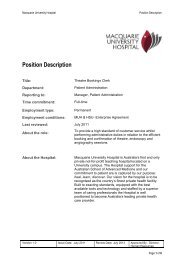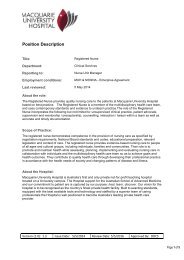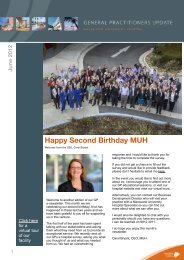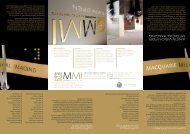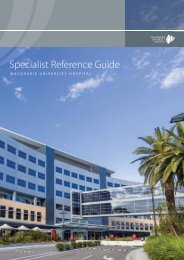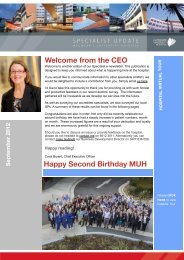Plenary Oral Presentations - Macquarie University Hospital
Plenary Oral Presentations - Macquarie University Hospital
Plenary Oral Presentations - Macquarie University Hospital
Create successful ePaper yourself
Turn your PDF publications into a flip-book with our unique Google optimized e-Paper software.
16 th International Meeting of the Leksell Gamma Knife ® SocietyMarch 2012, Sydney, AustraliaVA-50Treatment results of radiosurgery for cerebralarteriovenous malformations in the modern APS eraShunsuke Kawamoto, Fumi Higuchi, Phyo KimDepartment of Neurosurgery, Dokkyo <strong>University</strong> School of MedicineObjective: The authors sought to assess the efficacy and safety of gamma knife radiosurgery (GKRS)with meticulously-planned conformal coverage using multiple small isocenters in 47 patients withcerebral arteriovenous malformations (AVMs) treated by GammaKnife Type C between 2005 and2008.Methods: The mean volume of AVMs was 4.3 ml (range, 0.04-27.4). Eight patients had AVM niduslarger than 10ml. Dose planning was primarily based on MR angiography and was confirmed ondigital subtraction angiography (DSA). The mean marginal dose was 21.3 Gy (range, 16.7-25). Totalnumber of isocenters used in irradiation ranged from 2 to 76 (mean 27, median 27). In the follow-upperiod, MR images were taken every six months, and DSA was performed to confirm nidus obliterationat 3 years or earlier after GKRS. Outcomes such as the rates of obliteration, hemorrhage after treatment,and adverse radiation effects were analysed.Results: All the 46 patients were followed up for longer than 3 years. Thirty-seven of them underwentDSA and thirty-five (94.6%) showed complete obliteration. In Kaplan-Meier analysis, the completeobliteration rate at 36 months was 97.8% for AVMs with a volume of less than 10 ml. The margindose was the single factor associated with higher obliteration rate (p=0.022). Moderate to extensiveradiation-induced edema was revealed on MR images in 21.3% (10 of 47). The number of totalisocenters was the single significant factor associated with development of radiation-induced edema(p=0.03). Ten of 47 (21.3%) developed new or worsened neurologic symptom and three (6.4%)persisted. Six patients (12.8%) suffered hemorrhage from their AVMs after GKRS; two died of thehemorrhage and one became severely disabled. Among the eight patients with AVMs larger than 10ml, five (62.5%) suffered hemorrhage.Conclusions: Meticulous conformal coverage using multiple small isocenters contributed to higherobliteration rates at earlier stage after GKRS than previously reported, but does not lead to decreasein complication, and might be associated with higher bleeding rate with larger AVMs during thelatency period.71



